Introduction: An Artist of Influence
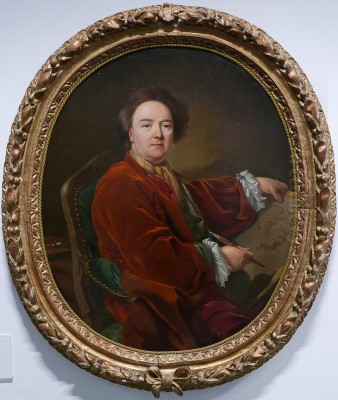
Charles-André van Loo, universally known in art history as Carle van Loo, stands as one of the most significant and successful painters of the 18th century in France. Born in Nice in 1705 and passing away in Paris in 1765, his life spanned a period of immense artistic flourishing, largely defined by the elegant and ornate Rococo style. Van Loo, however, was more than just a participant in this movement; he was a leading figure, whose talent and adaptability earned him the highest official artistic position in the kingdom: Premier Peintre du Roi, or First Painter to King Louis XV.
Hailing from a distinguished dynasty of artists of Dutch origin, Carle van Loo possessed a remarkable versatility. His extensive oeuvre encompasses grand history paintings, compelling religious scenes, intricate mythological narratives, fashionable portraits, and charming genre pieces. His ability to synthesize the grandeur of the Baroque tradition with the lighter graces of the Rococo made him exceptionally popular among the French monarchy and aristocracy, securing his place as a dominant force in the artistic landscape of his time.
Early Life and Artistic Formation in Italy
Carle van Loo's artistic journey began within a family deeply immersed in the arts. He was born in Nice, then part of the Duchy of Savoy, into a lineage tracing back to the Dutch Golden Age painter Jacob van Loo, his grandfather. His father, Louis-Abraham van Loo, was also a painter. This familial environment undoubtedly provided his earliest exposure to artistic practice. A pivotal moment came around 1712-1714 when, still a child, he followed his elder brother, Jean-Baptiste van Loo, also a painter destined for success, first to Turin and then to the artistic crucible of Rome.
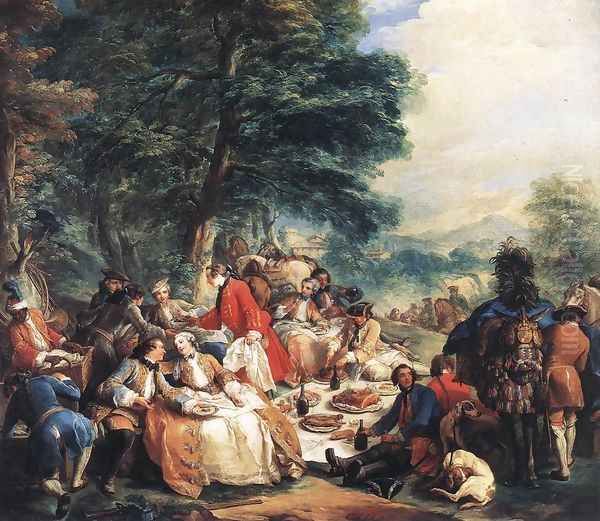
In Rome, the young Carle received formative training under notable masters. He studied with Benedetto Luti, a respected painter working in the late Baroque style, absorbing lessons in composition and colour. He also learned from the French sculptor Pierre Le Gros the Younger, which likely contributed to the sculptural quality often observed in his painted figures. This period immersed him in the masterpieces of Italian art, from the High Renaissance to the prevailing Baroque, profoundly shaping his artistic vocabulary. His talent was formally recognized in 1724 when he won the prestigious Prix de Rome, a prize awarded by the French Académie Royale, although financial difficulties initially prevented him from fully taking up the scholarship. He spent further time working in Turin before eventually returning to Rome for a more extended period (1727-1734).
Establishing a Career in Paris
After his extensive Italian sojourn, Carle van Loo returned to Paris in 1734, equipped with technical skill, a sophisticated understanding of artistic traditions, and considerable ambition. The Parisian art world, centered around the powerful Académie Royale de Peinture et de Sculpture, quickly recognized his abilities. In 1735, he was formally accepted (agréé) into the Academy and swiftly achieved full membership (reçu) the same year with his painting Apollo Flaying Marsyas.
His rise within the academic and social hierarchy was rapid. He became an assistant professor at the Academy in 1736 and a full professor just a year later, in 1737. Van Loo's technical proficiency, combined with his ability to work across various genres – from large-scale history paintings to intimate portraits – made him highly sought after. He began receiving significant commissions, establishing a reputation for reliability and excellence that would soon attract the attention of the highest echelons of French society, including the Royal Court itself.
Royal Patronage and Official Recognition
The reign of Louis XV marked a period of lavish artistic patronage, and Carle van Loo became one of its primary beneficiaries. His skill, versatility, and perhaps his agreeable personality, made him a favourite at court. He received commissions directly from the King and Queen Marie Leszczyńska, as well as from influential figures like Madame de Pompadour, the King's official mistress and a major patron of the arts. His work adorned royal palaces and the residences of the nobility.
His standing reached its zenith in 1762 when he was appointed Premier Peintre du Roi (First Painter to the King), succeeding Charles-Joseph Natoire in this prestigious role. This position placed him at the very top of the artistic hierarchy in France, responsible for overseeing royal commissions and influencing artistic taste. Further honours followed: he was awarded the Order of Saint Michael in 1763 and, in the final year of his life, 1765, he was named Director of the Académie Royale. These appointments solidified his status as the most celebrated and officially sanctioned painter of his generation in France.
Artistic Style: A Synthesis of Grandeur and Grace
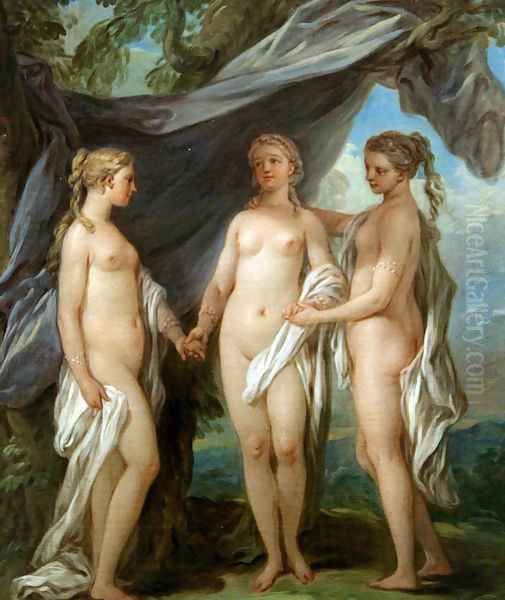
Carle van Loo's style is often characterized as a masterful blend of the late Baroque's dramatic intensity and compositional grandeur with the Rococo's characteristic lightness, elegance, and decorative sensibility. Having trained extensively in Italy, he deeply admired the masters of the past, including the Carracci and Domenichino, yet he adapted these influences to suit the prevailing tastes of 18th-century France. His connection to the French classical tradition, exemplified by artists like Charles Le Brun, is also evident in the clarity and order of his compositions, particularly in his history paintings.
Compared to his contemporary François Boucher, whose work often epitomizes the more sensual and overtly playful aspects of Rococo, Van Loo's art frequently exhibits a greater sense of restraint, solidity, and sometimes a cooler, more silvery palette. However, he was perfectly capable of adopting a warmer, more typically Rococo chromatic range when the subject demanded it. His figures are generally well-drawn, possessing a tangible presence, and his compositions are carefully constructed, whether depicting complex historical events or intimate mythological encounters. This adaptability allowed him to excel across the hierarchy of genres, from the most esteemed history painting down to portraiture and genre scenes, always maintaining a high level of technical polish and decorative appeal. His contemporaries included masters like the portraitist Jean-Marc Nattier and the master of quiet observation, Jean-Baptiste-Siméon Chardin.
Major Commissions and Monumental Works
Van Loo's position as a leading court painter resulted in numerous significant commissions, particularly for the decoration of royal residences. He contributed works to the Palace of Versailles, the Château de Fontainebleau, and other important sites. One notable project involved a series of nine vibrant Exotic Hunt paintings (Chasses exotiques, 1735-1739) created for the King's small apartments at Versailles, showcasing his ability to handle dynamic action and decorative detail.
Perhaps his most famous commission related to interior decoration came from Madame de Pompadour for her Château de Bellevue. Around 1753, he painted a set of four allegorical overdoor panels representing the Arts: Painting, Sculpture, Architecture, and Music. These works, now dispersed but with Music and Architecture in the Legion of Honor Museum, San Francisco, are prime examples of his elegant Rococo style applied to allegorical themes, featuring graceful figures and charming putti set within decorative frameworks.
Representative Paintings: History, Myth, and Religion
Carle van Loo's versatility is evident in the range of his masterpieces. The Hunting Halt (c. 1737, Louvre Museum, Paris) is a celebrated large-scale genre painting depicting Louis XV and his courtiers pausing during a hunt. It masterfully captures the leisurely elegance and opulent detail associated with aristocratic life in the Rococo era, blending portraiture with genre elements.

Mythological subjects provided ample opportunity for displaying grace and narrative skill. Bacchus and Ariadne showcases his ability to render classical figures with Rococo charm. The Three Graces (1763), depicting Aglaea, Euphrosyne, and Thalia, is another quintessential Rococo subject handled with characteristic elegance and a focus on idealized beauty. Apollo Flaying Marsyas, his reception piece for the Academy, demonstrated his command of dramatic historical narrative derived from classical myth. The Archer of Love (1761) became a widely popular image, embodying the playful allegories favoured at the time.
Religious painting remained a significant part of Van Loo's output, often executed on a grand scale. His series depicting the life of Saint Augustine for the church of Notre-Dame des Victoires in Paris, including Saint Augustine Preaching before Valerius, Bishop of Hippo (c. 1748-1755) and The Baptism of Saint Augustine (1755), were highly acclaimed. These works demonstrate his capacity for complex multi-figure compositions and serious religious expression, adapted to the prevailing aesthetic. The Resurrection of Christ (Patrick and Beatrice Haggerty Museum of Art, Marquette University) further attests to his skill in this genre. Regarding historical subjects, while he lived much later than Marie de' Medici, he did paint historical scenes featuring figures from the past, potentially including works depicting events from her life, following a tradition famously established by Peter Paul Rubens generations earlier.
Portraiture: Capturing the Elite
While perhaps less renowned for portraiture than his brother Jean-Baptiste or his nephew Louis-Michel van Loo (who became court painter in Spain), Carle was nonetheless a highly accomplished portraitist. His position naturally led to commissions from the royal family, including portraits of Louis XV and Queen Marie Leszczyńska. These works typically combined the required formality of state portraiture with the fashionable elegance and refined technique characteristic of the Rococo.
His reputation extended beyond France, leading to prestigious international commissions. He notably painted a portrait of Empress Elizabeth Petrovna of Russia, a testament to his European renown. There are also mentions of portraits of other prominent figures like King Stanisław August Poniatowski of Poland. These portraits served not only as likenesses but also as statements of status and refinement, perfectly aligning with the social codes of the European aristocracy.
The Van Loo Dynasty and Artistic Circles
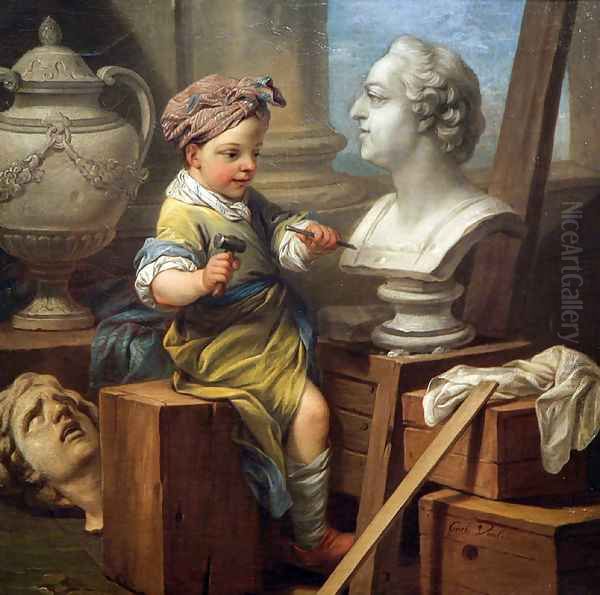
Carle van Loo was the most celebrated member of an extraordinary artistic dynasty that spanned several generations and countries. The legacy began with his grandfather Jacob in the Netherlands and continued through his father Louis-Abraham and his highly successful brother Jean-Baptiste. Carle's own success further elevated the family name. His influence extended to the next generation: his nephew Louis-Michel van Loo achieved great success as a court painter in Madrid, and his own sons, Jules-César-Denis van Loo and Charles Amédée Philippe van Loo, also became painters, with Charles Amédée notably working for King Frederick the Great of Prussia.
Within the Parisian art world, Carle van Loo moved in the highest circles. He was a colleague and sometimes a rival of other leading artists like François Boucher, Jean-Marc Nattier, and Charles-Joseph Natoire. He interacted with figures like the influential critic Denis Diderot, who frequently commented on his works exhibited at the biennial Paris Salons. His studio was also an important training ground for younger artists, disseminating his style and techniques. He would have known the work of earlier Rococo masters like Antoine Watteau and later figures such as Jean-Honoré Fragonard and Jean-Baptiste Greuze, forming part of the rich tapestry of French art during this period. His time in Rome also connected him with figures like Sebastiano Ricci and Nicolas Vleughels, then Director of the French Academy in Rome.
Critical Reception: Acclaim and Controversy
During his lifetime, Carle van Loo enjoyed immense success and widespread critical acclaim. He was lauded for his technical mastery, his versatility across genres, and his ability to fulfill prestigious commissions with reliability and elegance. Critics like Diderot, while sometimes offering nuanced or even sharp critiques, generally acknowledged his preeminent position, particularly as a history painter capable of handling grand compositions. He was seen by many as the leading painter in France, especially after the death of Boucher in 1770 (though Van Loo himself died earlier, in 1765).
However, his very success and alignment with official taste sometimes led to criticism. Some found his work technically brilliant but perhaps lacking the deeper emotional resonance or painterly verve of artists like Boucher or Watteau. He was occasionally accused of being too academic, his compositions sometimes deemed cold or overly calculated. The emphasis on polish and decorum, while valued by his patrons, could be seen by others as a limitation.
Later Reputation and Legacy
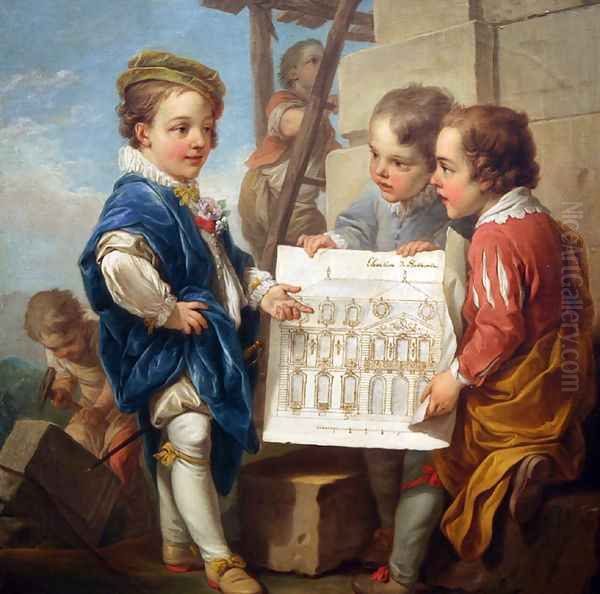
With the shift in artistic taste towards Neoclassicism in the later 18th century, spearheaded by artists like Jacques-Louis David, Van Loo's reputation, along with that of the Rococo style in general, began to decline. His work came to be seen as representative of the perceived frivolity and artificiality of the Ancien Régime. Throughout much of the 19th century, he was somewhat overshadowed by artists whose styles aligned better with Romantic or Realist sensibilities.
However, the 20th and 21st centuries have witnessed a significant reassessment of Carle van Loo and 18th-century French art. Art historians now recognize his exceptional technical skill, his important role as a synthesizer of Baroque and Rococo traditions, and his central position within the artistic institutions and patronage systems of his time. His ability to navigate the complex demands of courtly commissions while maintaining a high standard of artistry is widely acknowledged. His works are now prized possessions of major museums around the world, including the Louvre, the Getty Center, the Metropolitan Museum of Art, and the Hermitage Museum, studied and appreciated for their historical significance and artistic merit.
Conclusion: A Defining Figure of an Era
Carle van Loo remains a pivotal figure in the history of 18th-century European art. As Premier Peintre du Roi, he represented the pinnacle of official artistic success under Louis XV, embodying the tastes and aspirations of the French court. His prolific output, demonstrating mastery across the hierarchy of genres, showcased a remarkable blend of inherited Baroque grandeur and fashionable Rococo elegance. He led one of Europe's most prominent artistic families and played a crucial role within the Académie Royale. While his reputation has fluctuated according to changing artistic fashions, his technical brilliance, historical importance, and the sheer quality of his best works secure his legacy. Carle van Loo stands as a defining master of the French Rococo, an artist whose career illuminates the complex interplay of talent, patronage, and institutional power in the art world of the Ancien Régime.